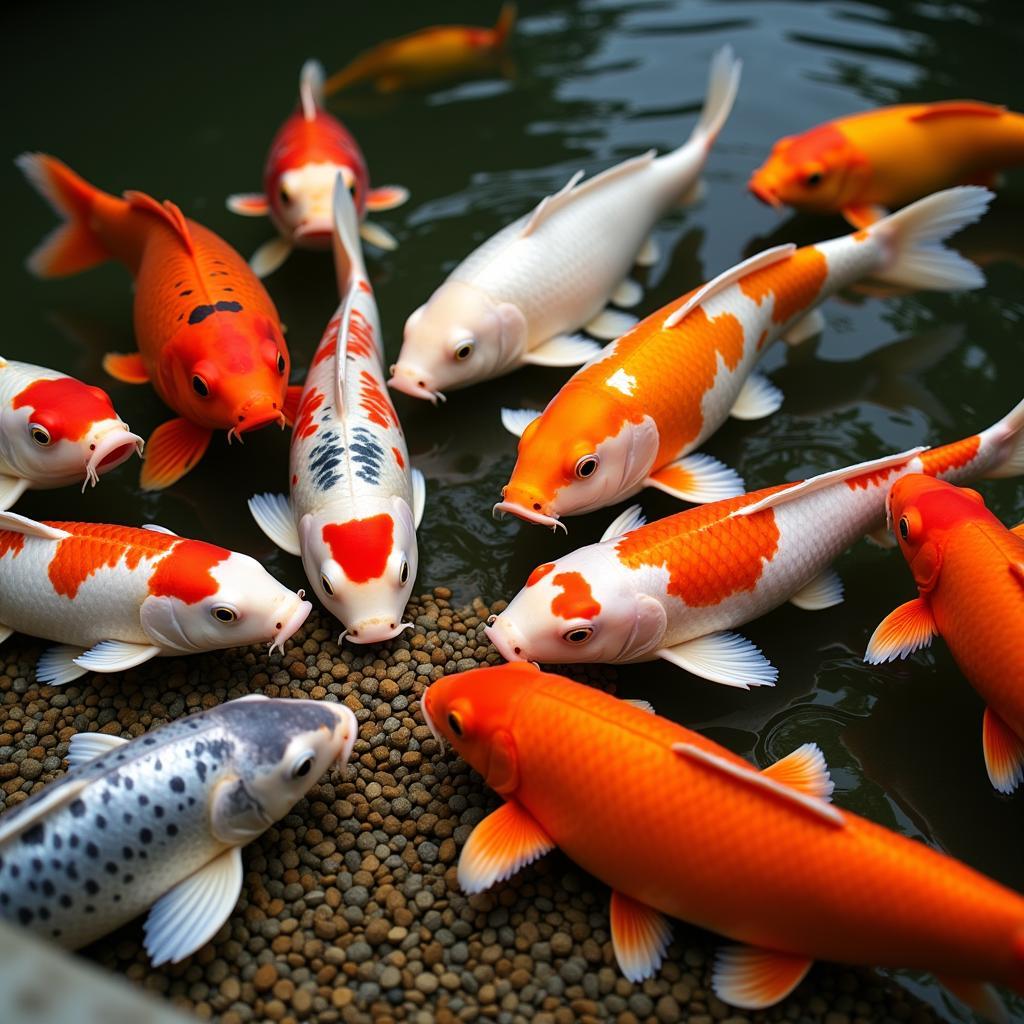Koi Food Sinking to the bottom of the pond might seem inconsequential at first, but it can actually point to a variety of issues, from improper feeding practices to underlying water quality problems. As koi keepers, it’s crucial to understand why your koi food is sinking and what it means for the health and well-being of your finned friends.
 Koi Fish Consuming Sinking Food Pellets
Koi Fish Consuming Sinking Food Pellets
The Science Behind Sinking Koi Food
Not all koi food is created equal. In fact, koi food comes in two main varieties: floating and sinking. While floating pellets are designed to stay on the surface, encouraging koi to feed at the top, sinking pellets are formulated to sink to the bottom. The reason behind this difference lies in the ingredients and the manufacturing process.
Sinking koi food typically contains higher amounts of protein and wheat germ, making it denser than its floating counterpart. This density causes the pellets to sink. While sinking food might seem like a natural way for bottom-feeding koi to eat, consistently finding uneaten pellets at the bottom of your pond can be a red flag.
Why is My Koi Food Sinking a Problem?
While sinking koi food serves a purpose, discovering an abundance of uneaten, sinking pellets in your pond can be a cause for concern. Here’s why:
-
Water Quality Issues: Sinking food that isn’t consumed decomposes at the bottom of the pond. This decomposition process uses up dissolved oxygen, potentially creating an environment unsuitable for your koi. Furthermore, decaying food can release harmful toxins like ammonia and nitrites, impacting water quality and putting your koi’s health at risk.
-
Overfeeding: Finding excessive amounts of sinking food at the bottom of the pond is a telltale sign of overfeeding. Just like any other pet, koi will only eat what they need. Overfeeding not only contributes to water quality issues but can also lead to health problems for your koi in the long run.
-
Improper Food Choice: While some koi naturally prefer to graze at the bottom, consistently providing only sinking food can prevent koi that prefer feeding at the surface from getting their share. This can lead to nutritional deficiencies and competition among your fish.
What to Do About Sinking Koi Food
If you find yourself facing the issue of sinking koi food, don’t worry! Here are some steps you can take to address the problem:
-
Reduce Feeding Amounts: Start by reducing the amount of food you provide at each feeding session. Observe your koi and only offer what they can consume within 5 minutes.
-
Offer a Variety: Introduce both floating and sinking koi food into your feeding routine. This ensures that all your koi, regardless of their feeding preference, have access to food and receive a balanced diet.
-
Invest in a Pond Vacuum: Regularly removing uneaten food and debris from the bottom of your pond is essential. A pond vacuum can be a valuable tool for maintaining a clean and healthy environment for your koi.
-
Monitor Water Quality: Regularly testing your pond water for ammonia, nitrites, nitrates, and pH is crucial for early detection of any potential problems.
Tips for Choosing the Right Koi Food
Choosing the right koi food is vital for their health, growth, and vibrancy. Here are a few things to keep in mind:
-
Read the Label: Pay close attention to the ingredients list. Look for high-quality protein sources like fish meal, shrimp meal, or krill meal as the primary ingredients.
-
Consider the Season: Koi’s dietary needs change with the seasons. Opt for higher protein foods during the warmer months when they are more active and lower protein options during the colder months.
-
Consult with Experts: Don’t hesitate to consult with a koi specialist or your local aquarium store for personalized recommendations based on your koi’s age, size, and the specific conditions of your pond.
 Variety of Koi Food Pellets for Optimal Nutrition
Variety of Koi Food Pellets for Optimal Nutrition
Expert Insights
“Many koi keepers overlook the importance of providing a balanced diet and observing their koi’s feeding habits,” says Dr. Susan Miller, an aquatic veterinarian with over 20 years of experience. “Switching to a higher quality koi food and incorporating a mix of sinking and floating pellets can make a world of difference in the health and vitality of your koi.”
Remember, a healthy koi is a happy koi. By understanding the reasons behind sinking koi food and taking proactive steps to address the issue, you can ensure that your koi thrive in a clean and enriching environment.
Conclusion
While the sight of your koi gracefully consuming sinking pellets might seem natural, it’s essential to be aware of the potential problems associated with uneaten food accumulating at the bottom of your pond. By being mindful of your feeding practices, choosing the right type of food, and diligently monitoring water quality, you can ensure a healthy and vibrant life for your beloved koi. Remember, a little attention to detail can go a long way in creating a thriving aquatic haven for your finned companions.